Here are some pics of one of my favorite knives. It's a US military issue Pilot's Survival Knife made by Camillus in the early 1980's.
This particular knife has been US military issue since about 1960 and has been used by all branches of the US military. Originally designed by Marbles for the US Air Force in the 1950's, it has roots in the popularity of the Marbles Ideal hunting knife with American aircrews in WWII. Before 1960 it was issued with a 6" blade, and after around 1960 it was issued with a 5" blade. It has seen many wars, it has been made in the millions by several manufacturers, and it is still used by local civilians and military troops wherever the US military has been. It is not an uncommon knife to find in the hands of many American outdoorsmen and hunters.
Brand new they average only about $30 to $40, and they can often be had military surplus in new condition for about $20.
This knife I tweaked a bit to suit my own personal tastes. Personally, I really like this knife. The 5" blade of 1095 carbon steel takes and holds a good edge with a hardness somewhere around Rc 57 - 58. It's size and shape are good for a variety of tasks from fieldcraft to dressing out and butchering a deer.
The saw on the spine of the blade is actually very useful and there are many vital tasks it excels at. It was originally designed for sawing through an aluminum aircraft fuselage or a cockpit canopy. However, for rapidly making notches and grooves, an important wilderness survival task, the saw on the spine of this knife blade is awesome. Interesting enough, the notches the saw makes are perfectly sized for paracord.
The saw is also good for scoring bones for precise breaks (use the edge of one side of the saw and then smack it with the hammer pommel), and it can also just saw wood, such as when you need a clean, smooth cut. The teeth, originally designed to cut aluminum, are not self cleaning with wood, so larger sawing projects take a bit longer. The saw also acts like a really good wood rasp, with wood filing and shaping qualities reminiscent of a Nicholson 4 in Hand file.
The hammer pommel, in addition to being a hammer, allows the knife to be baton-ed straight into wood, in addition to standard batoning, but you do have to excersize some common sense about that particular task. However, the ability to do that does come in handy.
You can hammer with the handle clenched in your fist, or for precise hammering of things like small tacks and stuff, you can grasp the blade with the saw edge towards your palm, and hammer with the flat side of the hexagon head pommel.
The sharpened false edge on the front amongst other things also makes a good scraper, like for vegetables, plants, and bones, and can function as a draw knife.
The flat profile of the tip allows for a very sharp point for such tasks as initial cuts on game. The sharpened false edge adds to it's qualities for drilling holes in wood and other things, like if the knife is to be used for stabbing, such as tied to a pole and used as a spear or lance.
So far the sheath is an original military issue style sheath made for this model of knife, and it works pretty good, so making a new one hasn't been one of my top priorities. I did replace the original carborundum with a 1"x3" EZE-Lap diamond hone which fit the hone pouch on the sheath perfectly.
IMHO, this knife is pure function and not a participant in a beauty contest. To keep water and rust off of the steel handguard and out of the small area where the handguard and blade meet, I taped up the knife and used black automotive spray paint on the handguard, filling in the small crevices between the handguard and the blade with paint.
I also took a power sander and then a handheld sanding block to the blade. I noticeably slimmed up the profile and smoothed out the contours on the sides. I also gave it a convex edge. This blade now seriously cuts though stuff. It cut good before, now it cuts like an expensive Marbles hunting knife.
Since Marbles, the original designer of this knife, patterned it originally off of the Marbles Ideal, I wanted to make the knife have a similar cutting profile to a Marbles Ideal. Sort of like a Marbles Ideal with a saw on the back.
I buffed off the parkerizing. Parkerizing taints food that you cut and it was coming off anyway with the radical re-profiling. I used lemon juice to initially get a good patina going, and now through use, the patina has been getting better.
I added a lanyard. I didn't want to drill a hole, but the pommel is perfectly suited to tying a lanyard on. Some people wrap their PSK's handle in paracord. Myself, I'm not fond of doing that, as I don't like the feel of the grip after it's wrapped. I just prefer to have a lanyard and I keep some paracord tied to my multi-tool pouch.
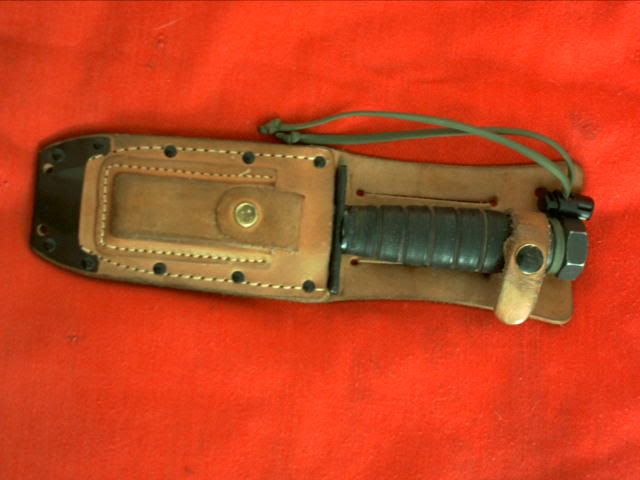
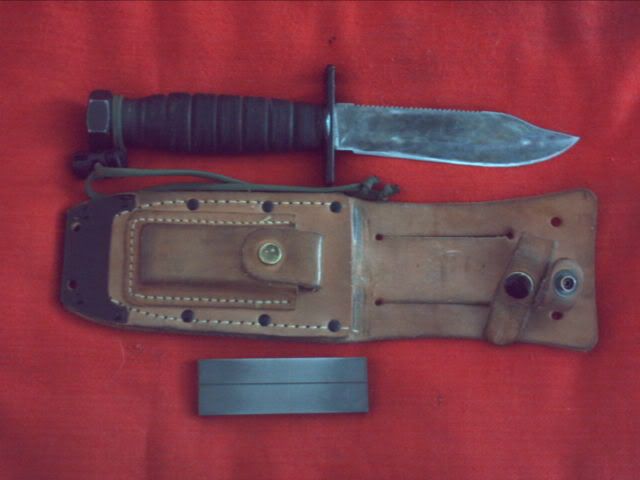
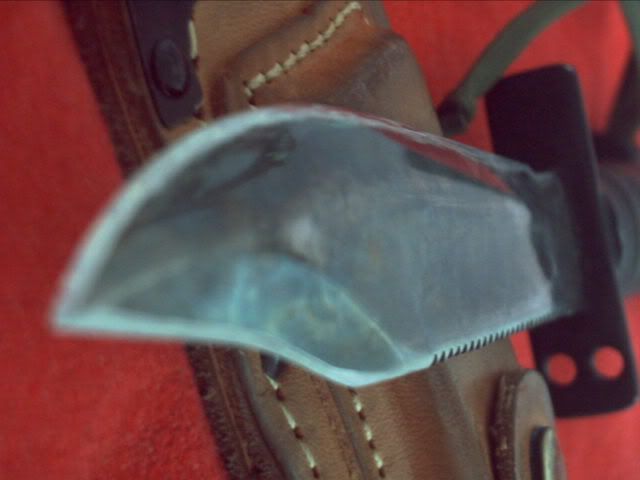
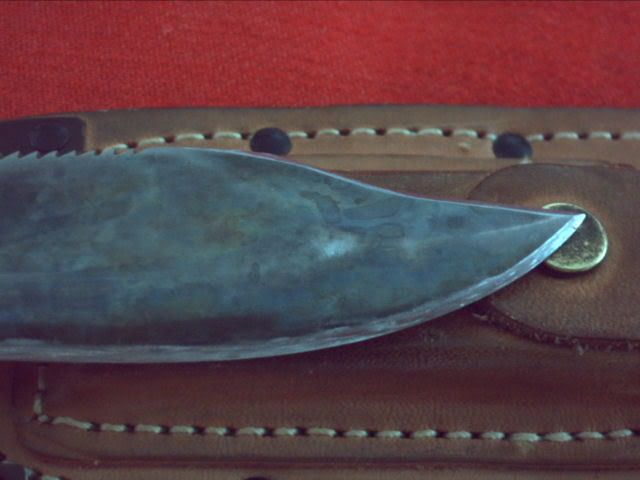
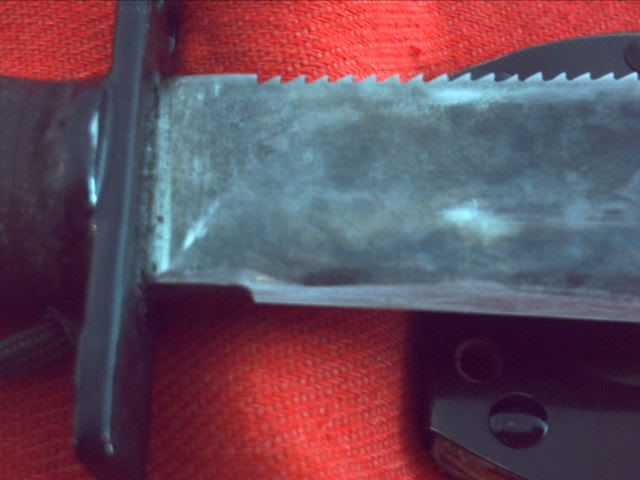
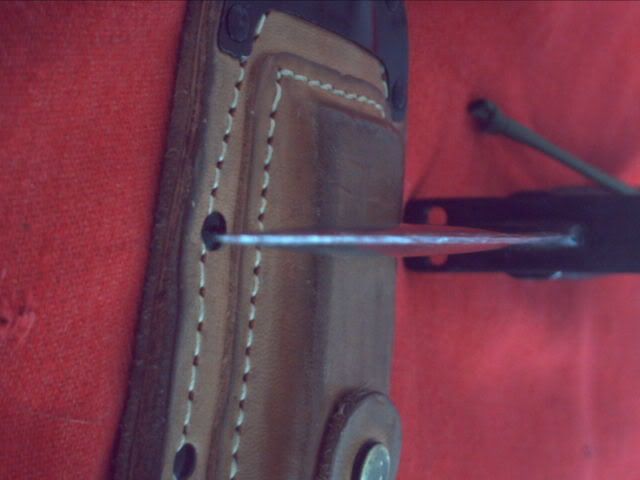
This particular knife has been US military issue since about 1960 and has been used by all branches of the US military. Originally designed by Marbles for the US Air Force in the 1950's, it has roots in the popularity of the Marbles Ideal hunting knife with American aircrews in WWII. Before 1960 it was issued with a 6" blade, and after around 1960 it was issued with a 5" blade. It has seen many wars, it has been made in the millions by several manufacturers, and it is still used by local civilians and military troops wherever the US military has been. It is not an uncommon knife to find in the hands of many American outdoorsmen and hunters.
Brand new they average only about $30 to $40, and they can often be had military surplus in new condition for about $20.
This knife I tweaked a bit to suit my own personal tastes. Personally, I really like this knife. The 5" blade of 1095 carbon steel takes and holds a good edge with a hardness somewhere around Rc 57 - 58. It's size and shape are good for a variety of tasks from fieldcraft to dressing out and butchering a deer.
The saw on the spine of the blade is actually very useful and there are many vital tasks it excels at. It was originally designed for sawing through an aluminum aircraft fuselage or a cockpit canopy. However, for rapidly making notches and grooves, an important wilderness survival task, the saw on the spine of this knife blade is awesome. Interesting enough, the notches the saw makes are perfectly sized for paracord.
The saw is also good for scoring bones for precise breaks (use the edge of one side of the saw and then smack it with the hammer pommel), and it can also just saw wood, such as when you need a clean, smooth cut. The teeth, originally designed to cut aluminum, are not self cleaning with wood, so larger sawing projects take a bit longer. The saw also acts like a really good wood rasp, with wood filing and shaping qualities reminiscent of a Nicholson 4 in Hand file.
The hammer pommel, in addition to being a hammer, allows the knife to be baton-ed straight into wood, in addition to standard batoning, but you do have to excersize some common sense about that particular task. However, the ability to do that does come in handy.
You can hammer with the handle clenched in your fist, or for precise hammering of things like small tacks and stuff, you can grasp the blade with the saw edge towards your palm, and hammer with the flat side of the hexagon head pommel.
The sharpened false edge on the front amongst other things also makes a good scraper, like for vegetables, plants, and bones, and can function as a draw knife.
The flat profile of the tip allows for a very sharp point for such tasks as initial cuts on game. The sharpened false edge adds to it's qualities for drilling holes in wood and other things, like if the knife is to be used for stabbing, such as tied to a pole and used as a spear or lance.
So far the sheath is an original military issue style sheath made for this model of knife, and it works pretty good, so making a new one hasn't been one of my top priorities. I did replace the original carborundum with a 1"x3" EZE-Lap diamond hone which fit the hone pouch on the sheath perfectly.
IMHO, this knife is pure function and not a participant in a beauty contest. To keep water and rust off of the steel handguard and out of the small area where the handguard and blade meet, I taped up the knife and used black automotive spray paint on the handguard, filling in the small crevices between the handguard and the blade with paint.
I also took a power sander and then a handheld sanding block to the blade. I noticeably slimmed up the profile and smoothed out the contours on the sides. I also gave it a convex edge. This blade now seriously cuts though stuff. It cut good before, now it cuts like an expensive Marbles hunting knife.
Since Marbles, the original designer of this knife, patterned it originally off of the Marbles Ideal, I wanted to make the knife have a similar cutting profile to a Marbles Ideal. Sort of like a Marbles Ideal with a saw on the back.
I buffed off the parkerizing. Parkerizing taints food that you cut and it was coming off anyway with the radical re-profiling. I used lemon juice to initially get a good patina going, and now through use, the patina has been getting better.
I added a lanyard. I didn't want to drill a hole, but the pommel is perfectly suited to tying a lanyard on. Some people wrap their PSK's handle in paracord. Myself, I'm not fond of doing that, as I don't like the feel of the grip after it's wrapped. I just prefer to have a lanyard and I keep some paracord tied to my multi-tool pouch.






